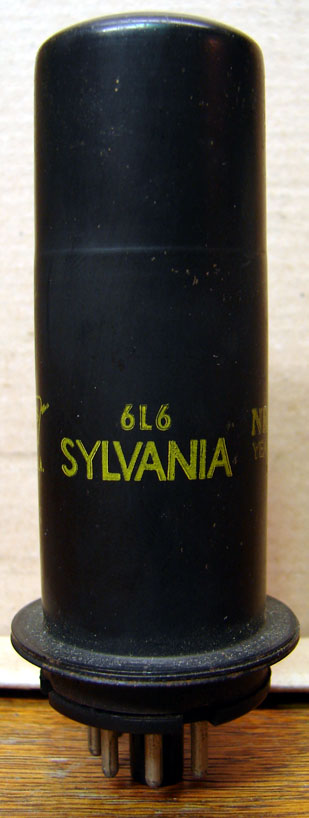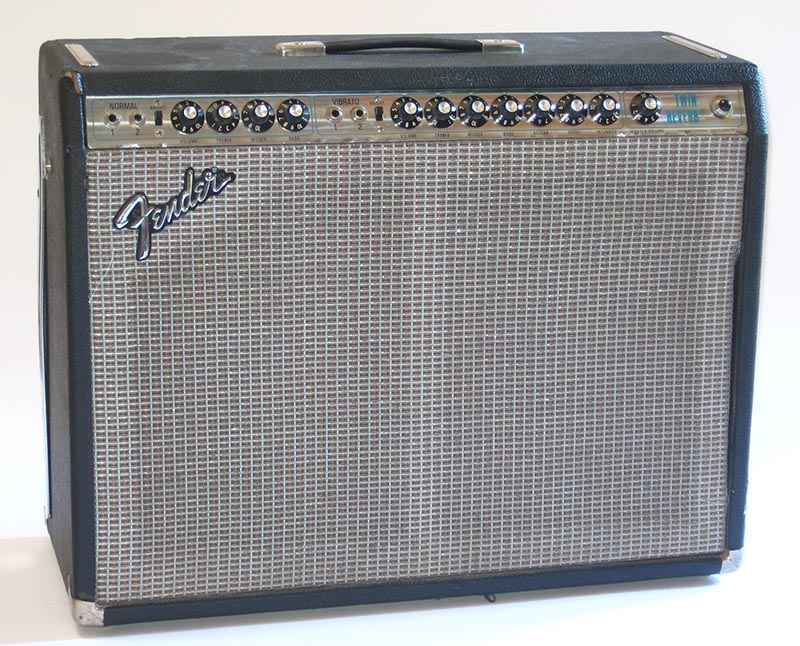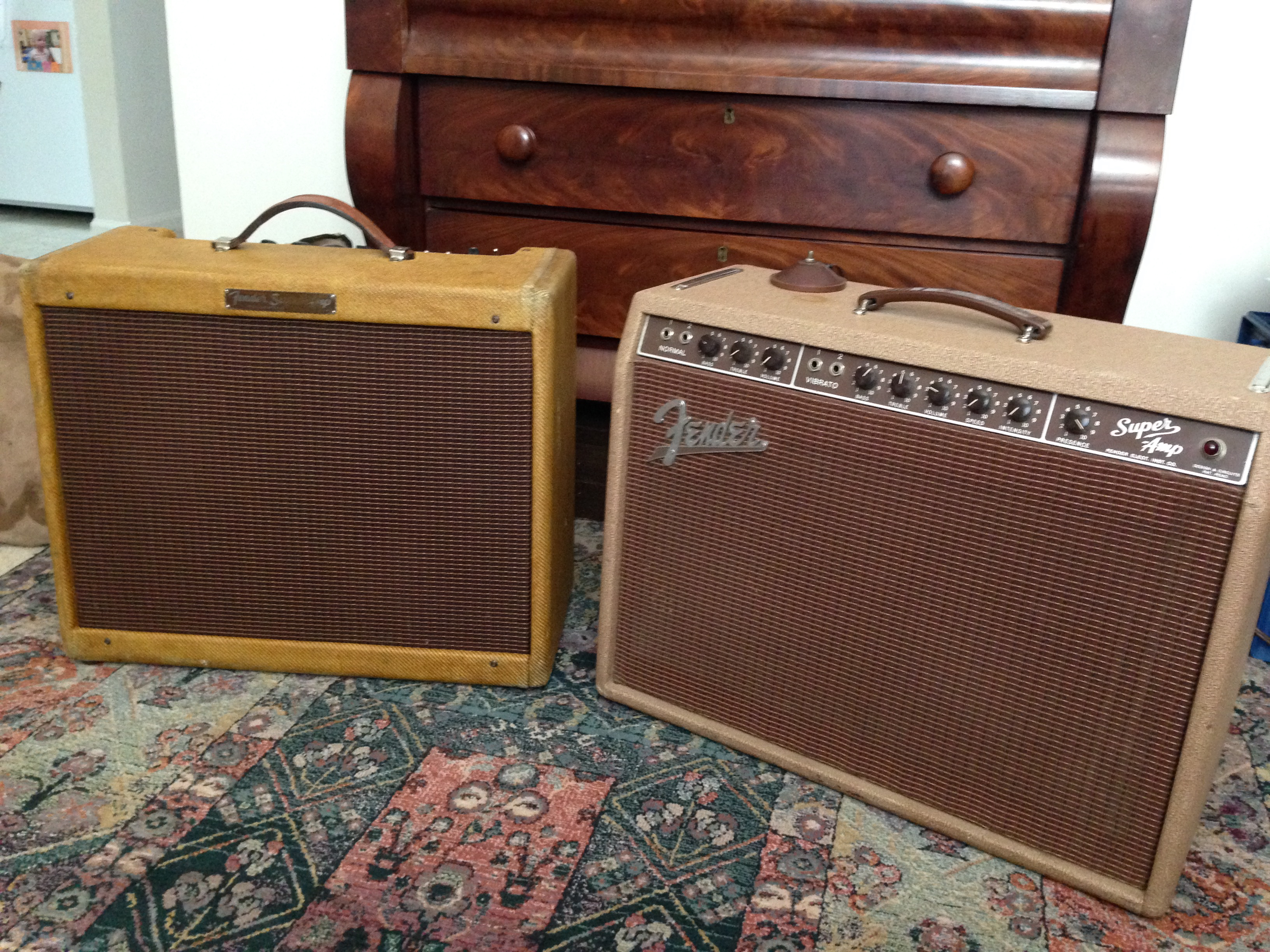|
Fender Pro
The Fender Pro was an instrument amplifier manufactured by Fender Electric Instruments from 1946 to 1965. It was characterized by its dual 6L6-family power tubes and single 15" speaker, with output power increasing from 18 watts up to 40 watts over its production run. The Pro was replaced in the Fender lineup by its offspring the Pro Reverb. History Woody The Professional was the largest of the three amplifiers Leo Fender produced at the launch of his company in 1946. It was built in small numbers on a special-order basis, and used the same circuitry and even the same chassis as the Model 26 ( Deluxe), with "Model 26" on the control plate scratched out and 6L6 tubes and larger transformers driving a 15-inch field coil speaker. The distinctive rear-panel cabinet was uncovered hardwood (maple, mahogany or walnut), with red, gold or blue grill cloth and vertical chrome bars in the center. Tweed In 1948 the Pro-Amp was part of Fender's revamped lineup in top-panel cabinets covered in ... [...More Info...] [...Related Items...] OR: [Wikipedia] [Google] [Baidu] |
Fender Musical Instrument Corporation
The Fender Musical Instruments Corporation (FMIC, or simply Fender) is an American manufacturer of instruments and amplifiers. Fender produces acoustic guitars, bass amplifiers and public address equipment, however it is best known for its solid-body electric guitars and bass guitars, particularly the Stratocaster, Telecaster, Jaguar, Jazzmaster, Precision Bass, and the Jazz Bass. The company was founded in Fullerton, California by Clarence Leonidas "Leo" Fender in 1946. Its headquarters are in Los Angeles, California. The FMIC is a privately held corporation, with Andy Mooney serving as the Chief Executive Officer (CEO). The company filed for an initial public offering in March 2012, but this was withdrawn five months later. In addition to its Los Angeles headquarters, Fender has manufacturing facilities in Corona, California (US) and Ensenada, Baja California (Mexico). As of July 10, 2012, the majority shareholders of Fender were the private equity firm of Weston Presidio ... [...More Info...] [...Related Items...] OR: [Wikipedia] [Google] [Baidu] |
Fender Pro Amp
Fender may refer to: Transport * Fender (boating), a bumper used to keep boats from banging into docks or each other * Fender (vehicle) or wing, a part of a motor vehicle that frames a wheel well * Fender, a "cow catcher" on a tram, see Pilot (locomotive) * Fender, part of a Western saddle Other uses * Fender (company), a U.S. manufacturer of stringed musical instruments and amplifiers ** List of products manufactured by Fender Musical Instruments Corporation * Fender (surname), a surname * Fender, Arkansas, a community in the United States * Fender Pinwheeler, a fictional character in the 2005 film ''Robots'' * The Fenders, a Brazilian rock band * Fireplace fender, a fireplace accessory See also * The Fender IV The Fender IV were an American surf rock band of the 1960s. The Fender IV were started up in Baltimore, by guitarist Randy Holden. Although almost prevented by a bumble bee, he successfully moved the band to Southern California in 1963, in o ..., a U.S. garage ... [...More Info...] [...Related Items...] OR: [Wikipedia] [Google] [Baidu] |
5881
6L6 is the designator for a beam power tube introduced by Radio Corporation of America in April 1936 and marketed for application as a power amplifier for audio frequencies.J. F. Dreyer Jr."The Beam Power Output Tube" New York: McGraw-Hill, ''Electronics'', April 1936, pp. 18 - 21, 35 The 6L6 is a beam tetrode that utilizes formation of a low potential space charge region between the anode and screen grid to return anode secondary emission electrons to the anode and offers significant performance improvements over power pentodes. The 6L6 was the first successful beam power tube marketed. In the 21st century, variants of the 6L6 are manufactured and used in some high fidelity audio amplifiers and musical instrument amplifiers. History In the UK, three engineers at EMI (Isaac Shoenberg, Cabot Bull and Sidney Rodda) had developed and filed patents in 1933 and 1934 on an output tetrode that utilized novel electrode structures to form electron beams to create a dense space charge re ... [...More Info...] [...Related Items...] OR: [Wikipedia] [Google] [Baidu] |
Rectifier
A rectifier is an electrical device that converts alternating current (AC), which periodically reverses direction, to direct current (DC), which flows in only one direction. The reverse operation (converting DC to AC) is performed by an Power inverter, inverter. The process is known as ''rectification'', since it "straightens" the direction of current. Physically, rectifiers take a number of forms, including Vacuum tube#Diodes, vacuum tube diodes, wet chemical cells, mercury-arc valves, stacks of copper and selenium rectifier, selenium oxide plates, Diode#Semiconductor diodes, semiconductor diodes, silicon-controlled rectifiers and other silicon-based semiconductor switches. Historically, even synchronous electromechanical switches and motor-generator sets have been used. Early radio receivers, called crystal radios, used a "Cat's-whisker detector, cat's whisker" of fine wire pressing on a crystal of galena (lead sulfide) to serve as a point-contact rectifier or "crystal detec ... [...More Info...] [...Related Items...] OR: [Wikipedia] [Google] [Baidu] |
Differential Amplifier
A differential amplifier is a type of electronic amplifier that amplifies the difference between two input voltages but suppresses any voltage common to the two inputs. It is an analog circuit with two inputs V_\text^- and V_\text^+ and one output V_\text, in which the output is ideally proportional to the difference between the two voltages: : V_\text = A(V_\text^+ - V_\text^-), where A is the gain of the amplifier. Single amplifiers are usually implemented by either adding the appropriate feedback resistors to a standard op-amp, or with a dedicated integrated circuit containing internal feedback resistors. It is also a common sub-component of larger integrated circuits handling analog signals. Theory The output of an ideal differential amplifier is given by : V_\text = A_\text(V_\text^+ - V_\text^-), where V_\text^+ and V_\text^- are the input voltages, and A_\text is the differential gain. In practice, however, the gain is not quite equal for the two inputs. This means ... [...More Info...] [...Related Items...] OR: [Wikipedia] [Google] [Baidu] |
Fender Bassman
The Fender Bassman is a bass amplifier series introduced by Fender during 1952. Initially intended to amplify bass guitars, the 5B6 Bassman was used by musicians for other instrument amplification, including the electric guitar, harmonica, and pedal steel guitars. Besides being a popular and important amplifier in its own right, the Bassman also became the foundation on which Marshall and other companies built their high-gain tube amplifiers. History The 5B6 Bassman During 1952, the Fender 5B6 Bassman amplifier was introduced as a combo amplifier cabinet that included the amplifier chassis combined with one 15" speaker. The 1952–1954 5B6 Bassman amplifiers had two 6SC7 or 6SL7GT pre-amp tubes, two 5881 power tubes and a single 5U4G rectifier tube. It was designed to generate 26 watts at an 8 ohm impedance load, and offered a cathode-based bias. From 1952 through the spring of 1954, Fender produced approximately 660 model 5B6 Bassman amplifiers (serial numbers #0001–0660). ... [...More Info...] [...Related Items...] OR: [Wikipedia] [Google] [Baidu] |
Fender Vibrasonic
The Fender Vibrasonic was an amplifier made by Fender. It was debuted as the first of the new-model Fender amps of the 1960s, with new tolex-covered cabinets and front-mounted control panels that would replace the tweed-covered, top-panel cabinets that were prevalent during the 1950s, as well as new circuitry which would characterize most Fender amplifiers for two decades. The Vibrasonic was introduced in 1959 and was discontinued in 1964. During this period, the "brownface" era, its brown control panel was matched with light brown ("tan") or standard brown tolex cabinets with grill cloth schemes typically in tweed style ("gold stripe") or yellow ("wheat"). At the time of its introduction, the Vibrasonic-Amp displaced the Fender Twin as the company's new top-of-the-line or "flagship" model. This elevated status was short-lived however, as the new high-powered 6G8 blonde Twin-Amp appeared in mid 1960. The Vibrasonic was one of the seven models in the newly designated Professiona ... [...More Info...] [...Related Items...] OR: [Wikipedia] [Google] [Baidu] |
Fender Showman
The Fender Showman was a guitar amplifier produced by the Fender company. It was introduced in 1960 and was discontinued in 1993. Blackface and Silverface models such as the Showman, Dual Showman, and Showman Reverb employed the same "piggyback head" design as the Bandmaster and the Bassman. Dual Showman Reverb used the Fender Twin Reverb chassis and came in non-master and master volume versions with "pull boost" circuitry, mid-1970s "tailless" amplifier decal and a slightly larger head. The Fender Showman is often associated with surf guitarist Dick Dale and was notably used in the 1960s by The Byrds, The Bobby Fuller Four, Fleetwood Mac with Peter Green, and in the 1970s by Steve Howe of Yes. Jimi Hendrix owned one early model, and later a Dual. Showmans and Dual Showmans are heavily sought by pedal steel guitar players. Technical data Six preamplifier tubes, solid state rectifier, four 6L6 power tubes and new output transformer. AB763 model: three preamplifier tubes (702 ... [...More Info...] [...Related Items...] OR: [Wikipedia] [Google] [Baidu] |
Fender Concert
The Fender Concert was a guitar amplifier made by Fender Musical Instruments. Its production can be split over 2 phases. The first of these running from 1960 and until approximately 1965, at which time a typical Fender Concert was priced at $315. During the 1960s, the Concert was for all practical purposes the same amplifier as the Vibrasonic but with four 10" speakers. In a later phase, the Concert was updated by Paul Rivera in the early 1980s ("concert" and "concert II") and a subsequent 1x12 variant of the Concert amp appeared briefly in the mid-1990s. Phase I: The 1960s The Fender Concert has gone through a number of changes over the years, both cosmetically and electronically. The Concert amp was introduced as a replacement for the 4-10 tweed Bassman amplifier. Due to the popularity of the Bassman, both amplifiers were produced concurrently during 1960. Unlike most of the other Professional Series amps however, the Concert (along with Fender Vibrasonic) were not previously of ... [...More Info...] [...Related Items...] OR: [Wikipedia] [Google] [Baidu] |
Fender Twin
The Fender Twin and Twin Reverb are guitar amplifiers made by Fender Musical Instruments Corporation. The Twin was introduced in 1952, two years before Fender began selling Stratocaster electric guitars. The amps are known for their characteristically clean tone. The Twin has seen a number of revisions since its introduction, both internal and external, with its designs sometimes varying greatly from one year to the next. Several variations on the amp's original design have been produced through the years, including the Twin Reverb, the Super Twin, the Twin Reverb II, the Twin Reverb '65 Reissue and the Twin Reverb 68’ Custom Reissues. The Cyber Twin, which combined a tube amp with a digital processor, was introduced in January 2001.YouTube page:The Fender Cyber-Twin: Full-Length DVD" Many notable musicians have used Fender Twin amplifiers, including Mark Knopfler, David Gilmour, Chuck Berry, Mike Oldfield, The BeatlesJohn Lennon and George Harrison of the Beatles both used Fen ... [...More Info...] [...Related Items...] OR: [Wikipedia] [Google] [Baidu] |
Fender Bandmaster
The Fender Bandmaster was a musical instrument amplifier made by Fender. It was introduced in 1953 and discontinued in 1974.Teagle, J. and Sprung, J.: Fender Amps: The First Fifty Years Some early models had both a microphone input and instrument inputs. Beginning in 1960, Bandmaster amps were equipped with a vibrato effect. In the 2000s, vintage Bandmaster amps remain in use by blues, Americana and rock and roll bands. File:1968_Fender_Bandmaster_front.jpg , Fender Bandmaster, silverface, 1968 "drip-edge" with AB763 circuit File:1968_Fender_Bandmaster_back.jpg , (back) Timeline ''Timeline gleaned from'' Cosmetics * Tweed * Blonde Blond (male) or blonde (female), also referred to as fair hair, is a hair color characterized by low levels of the dark pigment eumelanin. The resultant visible hue depends on various factors, but always has some yellowish color. The color can ... * Blackface * Silverface 1967–1974 ** Drip Edge 1967–1968 ** Black Line 1967– Circuit ... [...More Info...] [...Related Items...] OR: [Wikipedia] [Google] [Baidu] |
Fender Super
The Fender Super was a guitar amplifier made by Fender between 1947 and 1963 and, as the Super Reverb, until 1981. Though it was designed for a clean sound, its overdriven sound is praised by players and critics. History The Super evolved from the so-called Dual Professional, "often cited as the world's first twin-speaker amplifier," which was introduced in 1947. The Dual Professional had two slightly angled 10" Jensen speakers, and had two 6L6 tubes producing 18 watts. It was renamed the Super in the fall of 1947. The amplifier's circuit was changed in 1955 (until then it was identical to the Fender Pro, except for the speaker configuration) when the 6L6 tubes were exchanged for 6V6 tubes; the 1958 5F4 model was again equipped with 6L6 tubes, so its circuitry was again almost identical to that of the Pro (5E5-A model) and the Bandmaster (5E7 model). The 5F4 model had Presence, Bass, and Treble controls, and separate Volume controls for the microphone and instrument inputs. It ... [...More Info...] [...Related Items...] OR: [Wikipedia] [Google] [Baidu] |








